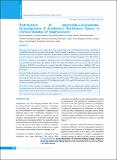Please use this identifier to cite or link to this item:
https://hdl.handle.net/20.500.14356/1510Full metadata record
| DC Field | Value | Language |
|---|---|---|
| dc.contributor.author | Nagarkoti, Dharma | - |
| dc.contributor.author | Prajapati, Krishna | - |
| dc.contributor.author | Sharma, Ajay Narayan | - |
| dc.contributor.author | Gyawali, Aarogya | - |
| dc.contributor.author | Manandhar, Sarita | - |
| dc.date.accessioned | 2023-05-14T10:49:38Z | - |
| dc.date.available | 2023-05-14T10:49:38Z | - |
| dc.date.issued | 2020 | - |
| dc.identifier.citation | NagarkotiD., PrajapatiK., SharmaA. N., GyawaliA., & ManandharS. (2021). Distribution of Macrolide-Lincosamide-Streptogramin B Antibiotics Resistance Genes in Clinical Isolates of Staphylococci. Journal of Nepal Health Research Council, 18(4), 734-740. https://doi.org/10.33314/jnhrc.v18i4.2891 | en_US |
| dc.identifier.issn | Print ISSN: 1727-5482; Online ISSN: 1999-6217 | - |
| dc.identifier.uri | http://103.69.126.140:8080/handle/20.500.14356/1510 | - |
| dc.description | Original Article | en_US |
| dc.description.abstract | Abstract Background: Staphylococci are posing threat due to increasing trend of antimicrobial resistance particularly methicillin. Macrolide lincosamide streptogramin B (MLSB) family of antibiotics is commonly used to treat such infections. This study was aimed to determine the prevalence of inducible clindamycin resistance and observation of erm and msr genes among Staphylococci isolated from tertiary care hospital of Nepal during July 2017 to March 2018. Methods: Staphylococci from different clinical specimens were identified and antibiotic susceptibility profile was assessed following Kirby Bauer disc diffusion method. The double disc diffusion or D-zone test as outlined in CLSI document M100-S24 was performed to examine inducible clindamycin resistant isolates. Multiplex PCR was performed for detection of erm and msr gene in isolates using specific primers for ermA, ermB, ermC, msrA and msrB genes. Results: Of the 60 Staphylococci isolates, 39 (65%) were S. aureus and 21 (35%) were coagulase negative Staphylococci (CNS) with 25 (64%) and 15 (71%) representing methicillin resistant S. aureus and CNS respectively. Constitutive and inducible MLSB phenotype was observed among 24 (40%) and 14 (23%) isolates respectively by D test. The most prevalent resistant gene was ermC (37%) followed by msrB (12%), ermB (10%) and msrA (10%). None of the isolates were found to possess ermA gene. Conclusions: The presence of constitutive and inducible MLSB as well as resistant genes among Staphylococci necessitates detection of such isolates to minimize treatment failure. The result from this study may help elucidate the predominant resistant characteristics in clinical Staphylococci isolated from tertiary care hospital of Nepal. Keywords: D test; erm gene; MLSB; msr gene; staphylococci. | en_US |
| dc.language.iso | en | en_US |
| dc.publisher | Nepal Health Research Council | en_US |
| dc.relation.ispartofseries | Oct-Dec, 2020;2891 | - |
| dc.subject | D test | en_US |
| dc.subject | Erm gene | en_US |
| dc.subject | MLSB | en_US |
| dc.subject | Msr gene | en_US |
| dc.subject | Staphylococci | en_US |
| dc.title | Distribution of Macrolide-Lincosamide-Streptogramin B Antibiotics Resistance Genes in Clinical Isolates of Staphylococci | en_US |
| dc.type | Journal Article | en_US |
| local.journal.category | Original Article | - |
| Appears in Collections: | Vol. 18 No. 4 (2020): Vol. 18 No. 4 Issue 49 Oct-Dec 2020 | |
Files in This Item:
| File | Description | Size | Format | |
|---|---|---|---|---|
| 2891-Manuscript-20010-1-10-20210122.pdf | Fulltext Download | 387.36 kB | Adobe PDF |  View/Open |
Items in DSpace are protected by copyright, with all rights reserved, unless otherwise indicated.
